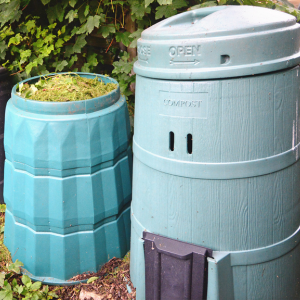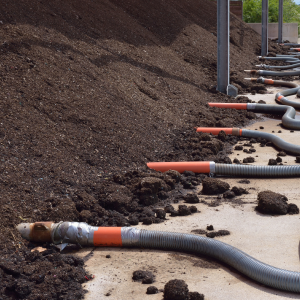
Home vs Industrial Composting
Embarking on the journey towards sustainable waste management, composting stands as a pivotal practice, offering both individual households and industrial facilities the means to transform organic waste into valuable resources. Here at CiboWares we have several products that are compostable at commercial industrial facilities, so we wanted to take some time to talk about the differences in home and commercial composting.
In this exploration, we delve into the intricacies of home composting and industrial composting, unraveling the distinct processes that occur within the confines of a backyard and on a larger, industrial scale. From the simplicity of turning kitchen scraps into nutrient-rich compost in a home bin to the sophisticated methods employed by industrial composting facilities, this comparison sheds light on the shared goal of reducing organic waste's environmental impact. Join us as we uncover the fundamental workings of home and industrial composting, emphasizing the significance of both in fostering a greener and more sustainable world.
What is Home Composting?
Home composting is a sustainable waste management practice that transforms organic kitchen and yard waste into nutrient-rich compost within the confines of one's residence. Typically carried out in backyard compost bins or designated composting areas, this process relies on the natural decomposition of organic matter by microorganisms. Common materials for home composting include kitchen scraps like fruit and vegetable peels, coffee grounds, and yard waste like leaves and grass clippings. Home composting not only diverts organic waste from landfills but also produces a valuable soil conditioner that enhances garden fertility. It's an accessible and eco-friendly way for individuals to contribute to reducing their environmental impact while nurturing their gardens or plants.
How Does Home Composting Work?
Each home composting method offers a unique approach to converting kitchen and yard waste into nutrient-rich compost, allowing individuals to choose the option that best suits their living space, lifestyle, and composting goals. Here are the most popular home composting options:
-
Rotary Drum Composting: There are now options to perform a variation of this method at home by using a compost tumbler. Small scale gardeners and farmers can buy a tumbler for their compost, or even make their own using, for example, a 50-gallon drum.

- Backyard Compost Bin: One of the most common methods, a backyard compost bin allows for the decomposition of kitchen scraps, yard waste, and other organic materials. It requires a balance of green (nitrogen-rich) and brown (carbon-rich) materials, occasional turning, and aeration to facilitate the composting process.
- Vermicomposting: Ideal for those with limited space, vermicomposting involves using specialized bins filled with red worms to break down organic matter. The worms consume kitchen scraps, producing nutrient-rich worm castings that make an excellent soil conditioner.
- Trench Composting: Suitable for gardeners, trench composting involves digging trenches in the garden and burying kitchen waste directly. Over time, the waste decomposes, enriching the soil. This method is convenient for integrating composting into gardening practices.
- Compost Piles or Heaps: Less structured than a bin, a compost pile involves creating a heap of organic materials in a designated area. Turning the pile regularly aids in aeration and decomposition. This method is versatile and suitable for larger quantities of waste.
What is Industrial Composting?
Industrial composting refers to the large-scale composting processes used to treat organic waste, typically from municipal, agricultural, or commercial sources. Various methods have been developed to handle the large quantities of waste produced and to expedite the composting process. Industrial composting is also often referred to as commercial composting.
How do Industrial Composting Systems Work?
The goal of each method is the same; to aid the composted items in biodegrading efficiently. This is so it can be used productively or at least disposed of in more planet friendly ways, instead of merely contributing to the planet’s waste. Let’s take a look at some of the methods science has come up with to make the most out of our compostable waste:
-
Windrow Composting: This method involves piling organic matter into long rows known as windrows. The rows vary in height across facilities. The rows are periodically turned to aerate the material, accelerate the composting process, and ensure uniform decomposition. This is done using front-end loaders or tractors in smaller operations or dedicated specialized machinery in large scale operations. This method is suitable for large volumes of organic waste, such as yard waste and agricultural residues

- Aerated Static Pile Composting: Organic waste is piled over a network of pipes that deliver air to the compost to ensure aerobic decomposition. It's a method commonly used for treating mixed yard and food waste. With this method, the compost is not turned manually, but relies on the network of pipes to aerate the material. It can take up less space than windrow composting and requires less labor as there is no need for people and machinery to turn the compost. However, setting up the pipes is a large investment and the method does require a power source.
- In-vessel Composting: This method uses a drum, silo, concrete-lined trench, or similar equipment to control environmental conditions and optimize the composting process. The vessel allows for better control over temperature, moisture, and aeration. It's faster than many other methods and is often used for food waste, bio-solids, and other organic materials. This method can be done in both small and large operations.
- Tunnel Composting: In this method, waste materials are placed in a closed tunnel. The environment inside the tunnel (temperature, humidity, and aeration) is controlled to expedite the composting process. After an initial phase in the tunnel, the compost is typically further matured in open-air facilities.
- Rotary Drum Composting: The compost material is placed inside a rotating drum. As the drum turns, the material is mixed and aerated, speeding up the composting process.
- Vertical Composting Units: These are multi-story, bin-like systems where organic materials are added to the top and mature compost is removed from the bottom. As materials decompose, they move downwards through the bin, making the process continuous. This is a more advanced and large-scale operation than what we can do at home, but the basic idea of removing the mature compost from the bottom and adding more material to the top is the same.
- Plug Flow Systems: These systems move composting material through a rectangular chamber using a combination of gravity and mechanical systems. The environment in each section of the chamber can be controlled to optimize different phases of the composting process.
The above are just some of the methods for industrial composting that can be used at both small and large scale operations. The type of industrial composting method chosen often depends on the type and volume of organic waste, space limitations, desired processing time, and budget constraints. Each method has its own advantages and challenges, so careful consideration is taken to ensure that the chosen process is overall beneficial.
Home Composting vs Industrial Composting
Both home and industrial composting aim to break down organic materials into a stable, humus-like product, but they differ in many aspects due to their scale, intended purpose, and the methods employed. Below, we take a look at some of the differences between home and industrial composting:
Scale and Volume
Home Composting: Typically handles a small amount of waste generated by individual households. This could be kitchen scraps, yard waste, and a few other compostable items.
Industrial Composting: Deals with large volumes of organic waste, often sourced from multiple locations, including entire communities, commercial establishments, and agricultural operations.
Types of Waste Handled
Home Composting: Generally limited to fruit and vegetable scraps, yard waste, eggshells, and coffee grounds.
Industrial Composting: Can handle a wider range of organic materials, including meat, dairy, and bones, which are often discouraged in home composting due to the potential attraction of pests. Industrial systems can also process materials like compostable plastics and larger volumes of yard waste.
Our molded fiber containers and tableware can be composted in industrial settings in some regions. This makes them a great alternative to polystyrene (Styrofoam) or plastic products.
Temperature and Processing Time
Home Composting: Typically operates at lower temperatures, and the decomposition process may take several months to a year. The lower temperature of home composting is part of the reason why our molded fiber products aren’t suitable for home composting; these materials need the higher temperatures of industrial composting to completely break down.
Industrial Composting: Reaches higher temperatures due to the larger volume and active aeration methods. This not only accelerates decomposition (often completed in weeks) but also ensures the destruction of pathogens and weed seeds.
Monitoring and Control
Home Composting: Generally passive, relying mostly on natural aeration and occasional turning.
Industrial Composting: More controlled and monitored. Parameters like temperature, moisture content, and oxygen levels are frequently checked and adjusted to optimize the composting process.
Final Product
Home Composting: Produces compost primarily for personal use in gardens or potted plants.
Industrial Composting: Produces large quantities of compost that can be sold commercially or used in large-scale agricultural or landscaping applications.
Environmental Controls
Home Composting: Little to no environmental controls. There might be occasional issues with odors or pests if not properly managed. Keeping pests and odors away is much easier if there is no meat, fish or other seafood, or dairy added to the compost. Pests are attracted to the smell of these foods that smell bad as they break down. Another way to avoid odor is to regularly turn or tumble the compost.
Industrial Composting: Usually has strict environmental controls in place. This includes systems to manage leachate (liquid runoff), emissions controls for odor, and sometimes methane capture from anaerobic processes.
Regulations and Oversight
Home Composting: Generally, has little regulatory oversight unless it's causing a nuisance or health hazard.
Industrial Composting: Subject to various regulations concerning public health, environmental impact, and quality of the final product. Facilities often require permits and regular inspections.
Equipment Used
Home Composting: Minimal equipment, usually just compost bins, tumblers, or simple piles.
Industrial Composting: Uses heavy machinery such as windrow turners, shredders, screeners, and aeration systems.
The scale of operation vastly differs between home and industrial levels of composting, as do the methods of management. Both methods are beneficial for the environment because they divert organic waste from landfills and returning nutrients to the soil.
Conquer Composting
Our exploration into home and industrial composting has laid bare the distinct characteristics of each method. We've examined their composting techniques, compared scales and volumes, dissected the types of waste they can handle, and delved into aspects like temperature control, process time, monitoring, and control mechanisms. As we conclude, it's evident that home composting offers a personalized, smaller-scale solution, ideal for individual commitment, while industrial composting, on a larger scale, caters to extensive waste management needs. Both methods, with their unique attributes, contribute significantly to the overall goal of sustainability by converting waste into valuable compost that enriches the soil for future use.
Looking for compostable products?
Shop these categories:






